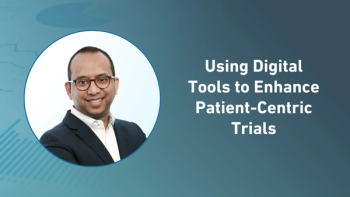
Consent in the Fast Lane
Breaking down the barriers to eConsent adoption.
Following the
eConsent can deliver enhanced experiences for patients and research sites and improve regulatory compliance for sponsors. But despite the rapid implementation of eConsent,2 challenges still exist, including barriers like patient preferences and regulatory acceptance that prevent wider adoption across study portfolios. The issues have a downstream impact due to the time it takes to create, deploy, and maintain electronic informed consent forms (eICFs) within eConsent systems, increasing study start-up and reconsenting timelines.
With a wide variety of eConsent solutions available to choose from, how can pharma companies narrow down to the best option? For clinical leaders reimagining the patient consent process or just getting started, think about how to best optimize to meet study needs and ways to improve the experience for sites and patients. As a baseline, start with a solution that supports compliance as outlined in GCP and is flexible enough to meet the varying guidance of local regulatory agencies. Here are four other key considerations when evaluating eConsent.
Supporting a global study pipeline
The globalization of clinical research is crucial when evaluating eConsent solutions, especially since the number of countries outside of the United States serving as study locations doubled from 2006 to 20163 and continues to grow. A fully scalable eConsent can support trials regardless of location, with the flexibility to adapt to local requirements like eSignature regulations and data privacy requirements.
Look for applications that provide robust capabilities for site- and user-friendly digital experiences, from the first receipt to eICF signature. This can help simplify engagement with the diverse range of patients global studies bring in. Prioritize features like executing print-to-sign for regions that require physical ‘wet ink’ signatures, options to capture consent in face-to-face or remote settings, and a choice between multi-factor authentication and finger/stylus digital signature.
Meeting study start-up timelines
Study start-up accounts for 61% of trial lifecycle times,4 making it one of the most time intense areas for clinical development. Bringing in an intuitive eConsent application that can be set up and deployed quickly could accelerate early trial processes. But many hesitate with introducing eConsent because of its perceived complexity compared to using paper documents and more familiar manual consenting workflows.
eConsent solutions with a simple eICF set-up that include multimedia like images and videos can speed execution while enhancing the patient experience. Reusable eICF templates that auto-distribute to reviewers and sites can further streamline early trial processes, as can working with central and local IRBs to ensure eICF reviewis managed within their existing processes. This eliminates burdensome manual processes and accelerates global eICF creation, approval, and distribution.
Improving the site experience
Managing sponsor-led systems is a significant burden for sites, especially since they use multiple systems across their studies. Each comes with distinct logins, processes, and requirements, and the slightest deviation increases the risk of noncompliance.
These challenges often lead to low site adoption rates of new applications. In fact, 70% of sponsors and CROs say their top challenge with decentralized trials is site technology adoption. Increase site utilization of eConsent with a solution that is easy to use, offers simple help and support, and addresses the day-to-day pains that site staff experience, including:
- Ensuring the most current version of consent is always used, eliminating version errors
- Flagging patients that need to be reconsented because of study changes, saving time
- Delivering easy access to documents, cutting hours spent previously searching through paper binders
- Offering a single eConsent experience across all studies for consistency
Increasing patient-centricity
Delivering a better patient experience in trials is an industry-wide priority. eConsent should move the industry closer to that goal by:
- Making it easier for patients to navigate, read, and comprehend long, complex documents with structured content
- Delivering content in a visual, more engaging way using multimedia
- Providing patients an opportunity to read eICF documents in advance, for ample time to discuss with friends or family members
- Ensuring flexibility for patients to select consent options based on their personal preferences
- Delivering fast, easy on-demand access to consent information during or after the study
Managing consent updates and amendments
Updates to consent forms are time-consuming for study teams and sites and often require the reconsenting of patients. This is a significant cause of noncompliance and creates confusion around what forms need to change. eConsent applications that provide study teams with the flexibility to quickly update eICFs and auto-distribute the approved version to relevant sites.
The application should also automatically provide sites with the latest eICFs, saving staff from searching and selecting forms manually and delivering visibility into whether a patient is current or requires reconsenting, ensuring all documents are up to date.
Enabling speed and transparency
Breaking the barriers to eConsent can help advance study execution and speed innovation. When evaluating applications, prioritize tools on the same platform as sponsor and site systems. This can get clinical leaders a step closer to establishing a digital and connected clinical ecosystem that provides a holistic view for stakeholders.
An eConsent solution allows sponsors to implement faster, maintain control, and ensure consistency across global studies. In the end, the application has the potential to provide a better experience for all—study teams, sites, and patients.
Kieran Connolly, senior director, MyVeeva for Patients strategy, Veeva Systems
References
- Veeva Systems,
Digital Clinical Trials Survey Report , 2021 - Clinical Trials Arena, 2022 forecast: decentralized trials to reach new heights with 28% jump, 2021
- Research Gate, The globalization of clinical trials: ethical and regulatory implications, 2016
- Tufts,
Tufts Center for the Study of Drug Development Impact Report , 2018.
Newsletter
Stay current in clinical research with Applied Clinical Trials, providing expert insights, regulatory updates, and practical strategies for successful clinical trial design and execution.




